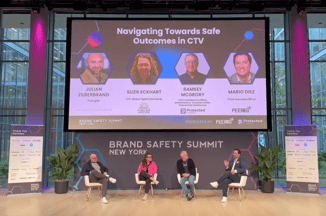The Hidden Costs of Keyword Blocking: Exploring Trade-Offs for Advertisers

In the world of digital advertising, brand safety remains a paramount concern for advertisers. With the rise of programmatic advertising and the proliferation of user-generated content, ensuring brand suitability and protecting brand reputation has become increasingly challenging. To mitigate risks, many advertisers resort to keyword blocking, a popular tactic that allows them to exclude certain keywords from their ad placements.
While keyword blocking can offer benefits in terms of brand safety, it also comes with hidden costs that can limit campaign reach and effectiveness. Advertisers should—like this article—explore the trade-offs of keyword blocking common mistakes in creating blocklists, and consider the best alternatives to keyword blocking.
What are the Costs of Keyword Blocking?
Keyword blocking, when implemented excessively, can lead to overblocking, which restricts the reach of digital advertising campaigns. Overblocking occurs when brand safety measures inadvertently prevent ads from appearing on web pages that contain relevant content.
Keyword blocklists can limit scale by excluding ads from appearing on web pages that may contain relevant and brand-safe content. For instance, during the coronavirus pandemic, advertisers employing broad keyword blocklists to avoid association with the virus inadvertently prevented their ads from appearing on legitimate news sites and web pages providing important information to the public, even positive stories like nightly neighborhood applause for nurses in New York and other heavily hit areas. This overblocking not only reduces the potential reach of campaigns but also limits advertisers' ability to contribute to the flow of accurate information.
Additionally, overreliance on keyword blocklists can lead to missed opportunities for advertisers to optimize their campaigns—an especially problematic issue for startups carving out an audience. By excluding keywords without considering contextual intelligence and real-time metrics, advertisers may overlook valuable placements and potential customers. Understanding the nuances of brand suitability and leveraging contextual targeting can provide more effective results without sacrificing reach and relevance.
What are the Benefits of Keyword Blocking?
While the costs of keyword blocking are evident, brands do find benefits, too. Keyword blocking allows advertisers to implement brand safety tactics by avoiding ad placements in contexts that may harm their brand reputation. Advertisers can safeguard their brand image and maintain trust with their audience by excluding keywords associated with sensitive topics, disinformation, or objectionable content.
Keyword blocking is considered a reliable method to control browsing and maintain a brand-safe environment. It provides advertisers with a sense of control over where their ads appear, ensuring that they align with their brand values and target audience. By employing keyword blocklists, advertisers can actively prevent their ads from being associated with irrelevant, offensive, or controversial content.
5 Common Mistakes in Creating Blocklists
Despite the benefits, there are common mistakes that advertisers may face when creating blocklists:
- Overblocking without context: Excessive keyword blocking without considering contextual intelligence can lead to missed opportunities, reduced inventory from an advertiser’s bid, and limited campaign scale.
- Static blocklists: Using static blocklists can be ineffective in dynamic environments, as trends and contexts change rapidly. Advertisers should regularly update and refine their blocklists to ensure ongoing brand suitability.
- Lack of granularity: Overly broad blocklists can hinder campaign optimization and prevent ads from reaching relevant and engaged audiences. Similarly, overblocking may block safe content and/or allow unsafe content to slip through. Advertisers should focus on refining their blocklists to include precise keywords and categories that align with their brand safety strategy.
- Relying solely on blocklists: Keyword blocklists should not be the sole method for ensuring brand safety. Employing additional brand safety measures, such as contextual targeting and real-time monitoring, can provide a more comprehensive approach.
- Limited visibility into ad placements: Advertisers often lack visibility into the specific web pages where their ads are placed. By partnering with ad verification providers like Moat, advertisers can gain more transparency and confidence in their placements, reducing the reliance on blocklists.
The Best Alternatives to Keyword Blocklists
To overcome the limitations of keyword blocklists, advertisers can explore alternative approaches that prioritize brand safety while maximizing campaign reach. Peer39 offers solutions that help brands maintain brand safety in a more effective manner.
By leveraging Peer39's contextual intelligence, advertisers can go beyond keyword blocking and employ contextual targeting. This approach ensures that ads are placed in environments with relevant content, thereby reaching engaged audiences while maintaining brand suitability.
Peer39's technology analyzes web pages in real-time, using advanced algorithms to understand the content's meaning, sentiment, and suitability. This enables more precise ad placements across Android-, Apple iOS-, Linux-, and Microsoft-powered devices and platforms, like Amazon Prime Video, Apple TV, and more.
Peer39's solutions extend beyond keyword analysis by incorporating semantic analysis, sentiment analysis, and other advanced techniques to provide a comprehensive understanding of web page content. By combining these sophisticated capabilities with machine learning and automation, Peer39 offers a scalable and efficient brand safety strategy for advertisers.
In addition to leveraging contextual intelligence, advertisers can consider other brand safety measures. This includes utilizing advanced adtech solutions that provide real-time monitoring and analysis of ad placements, like Oracle-owned Moat.
Moreover, advertisers can adopt contextual targeting approaches on popular social media platforms like Facebook, LinkedIn, and Twitter. These platforms offer granular targeting options, allowing advertisers to reach specific audiences based on demographics, interests, and behaviors. By combining these targeting capabilities with real-time metrics and optimization, advertisers can maximize the impact of their marketing campaigns.
Advertisers must also consider the pricing and functionality of alternative solutions. Advertisers should evaluate the cost-effectiveness and scalability of different brand safety strategies to ensure they align with their budget and objectives.
Rely on Proven Alternatives to Keyword Blocklists and Scale with Confidence
While keyword blocking remains a popular tactic for safeguarding brand safety in digital advertising, it is crucial for advertisers to consider the hidden costs and trade-offs associated with this approach. Overblocking can limit campaign reach and effectiveness, hindering optimization and missing valuable opportunities.
By understanding the benefits and drawbacks of keyword blocking, avoiding common mistakes in blocklist creation, and exploring alternatives like Peer39's contextual intelligence solutions, advertisers can strike a balance between brand safety and campaign performance.
With a comprehensive and adaptable brand safety strategy, advertisers can protect their brand reputation, engage with relevant audiences, and achieve their marketing goals in the ever-evolving digital advertising ecosystem.
Contact us today if you need help optimizing your keywords.
More Posts

Disrupting the Status Quo in CTV at the Brand Safety Summit
Transparency is a cornerstone of Peer39's solutions—CTV and otherwise—so it made perfect sense for us to participate in the open and honest discussions at the Brand Safety Summit in New York City on October 29 and 30.


